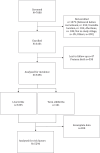Term stillbirths in Eastern Uganda: a community-based prospective cohort study
- PMID: 39898647
- PMCID: PMC11792121
- DOI: 10.1080/16549716.2024.2448895
Term stillbirths in Eastern Uganda: a community-based prospective cohort study
Abstract
Background: Every year, 1.9 million stillbirths occur worldwide, of whom 1.5 million occur in sub-Saharan Africa (SSA) and Southeast Asia.
Objectives: This study aims to determine the incidence and risk factors and to describe underlying causes for term stillbirths in Eastern Uganda.
Methods: This was a cohort study of pregnant women enrolled at 34 weeks of gestation or more and followed to birth between January 2021 and January 2024. Enrolment and follow-up were done in the community by trained midwives. Using structured questionnaires, details of maternal health, pregnancy and birth were captured.
Results: We enrolled 6101 participants and analysed 5496 for incidence of term stillbirth and 5296 for risk factors. Of the participants, 4913/5296 (92.8%) were between 14 and 35 years, and 4456/5296 (84.1%) had a health facility birth. There were 101 term stillbirths (61 were intrapartum and 40 antepartum). The incidence of term stillbirth was 18.4 per 1000 births (95% CI 14.8 to 22.9). The most common underlying causes of stillbirth were prolonged or obstructed labour 32/101 (31.7%) and malaria 20/101 (19.8%). The factors associated with term stillbirths were caesarean birth (aRR 3.3; 95% CI 2.00 to 5.4), intimate partner violence (aRR 1.8; 95% CI 1.1 to 2.8) and maternal age above 35 years (aRR 2.2; 95% CI 1.2 to 3.9).
Conclusion: Eastern Uganda has a high rate of term stillbirths with more than half occurring during labour. Efforts are needed to improve the quality of birth care and to prevent intimate partner violence.
Keywords: Stillbirths; causes; risk factors; term.
Plain language summary
Main findings: Prolonged labour and malaria were the most common attributable causes of term stillbirths in Eastern Uganda, while intimate partner violence and advanced maternal age were the identified risk factors.Added knowledge: Since there are limited recent data on stillbirths that include children born at home in Uganda, these results, which are based on over 6000 births, contribute to a better understanding of the current incidence, the common attributable causes and the risk factors of stillbirths in Uganda.Global health impact for policy and action: These results underscore the need for public health interventions to improve labour care, prevent malaria in pregnancy and reduce intimate partner violence in order to reduce stillbirths in Uganda.
Conflict of interest statement
No potential conflict of interest was reported by the author(s).
References
-
- Hug L, Mishra A, Lee S, et al. A neglected tragedy the global burden of stillbirths: report of the UN inter-agency group for child mortality estimation, 2020. U Nations Children’s Fund. 2020.
-
- You D, Hug L, Mishira A, et al. A neglected tragedy: the global burden of stillbirths, report of the UN inter-agency group for child mortality estimation, 2020. World Health Organisation (WHO). 2020. [Accessed on 08 May 2024 30 November]. Report No.
-
- Sustainable development goals United Nations website: United Nations . 2024. May 09 [cited 2024 May 9]. Available from:. https://www.un.org/sustainabledevelopment/sustainable-development-goals/
-
- Millenium Development Goals: United Nations . 2004. [cited 2024 Nov 19]. Available from: http://developmentgoals.org/Poverty.html
MeSH terms
LinkOut - more resources
Full Text Sources
Medical
Research Materials

